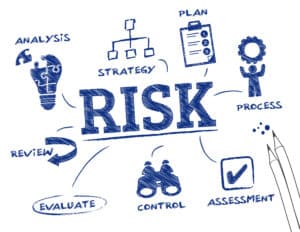
Approaching risk management with manual processes is a risk in itself. To manage cybersecurity and operational risks effectively, modern organizations need robust, automated, data-driven technology to get ahead and stay ahead of threats.
As the threats against your organization increase and grow in sophistication, understanding and managing applicable vulnerabilities and associated risks can often be confusing. Identifying and prioritizing the risks, threats, and vulnerabilities associated with critical business operations or new business endeavors maximizes your chances of success and enables you to prioritize the right amount of energy and attention on what matters most.
However, not all businesses define risks, threats, and vulnerabilities the same, making it difficult to understand the relevant exposure your organization is actually taking on. According to our first Cyber Risk Viewpoints Report, only 45% of respondents defined ‘risk’ in the same way, and only 47% defined ‘threats’ and ‘vulnerabilities’ in the same way. Understanding the differences and relationships between them empowers organizations to define mitigation strategies aligned with their areas of highest priority.
Risk mitigation can sometimes be confused with its strategic cousin, risk management.Risk management is the overall process of identifying, assessing, and controlling risk within a company or organization. This includes the identification and analysis of potential risks, as well as the implementation of a plan for managing business risks. On the other hand, risk mitigation focuses on minimizing the harm of a particular risk. This may involve implementing controls or safeguards to reduce the likelihood or impact of a risk, or developing contingency plans to minimize the harm to your organization if the risk is realized.
See also: How Can Digital Audit and Risk Monitoring Tools Improve Financial Services?
Risk mitigation strategies
Risk mitigation is crucial to reduce the exposure your organization has to potential harm. Here are ten common risk mitigation strategies to help organizations manage and minimize risk exposure effectively.
1. Risk Acceptance
Risk acceptance acknowledges a risk and accepts its potential consequences without taking further actions to mitigate or eliminate it. Although this approach is not ideal for all organizations, it is appropriate when the likelihood and impact of the risk are both low, and the cost of addressing it outweighs the potential benefits.
Risk acceptance may include keeping legacy systems active if they are not connected to sensitive data environments or allowing employees to connect their own devices to an organization’s networks if traffic from these devices is segmented from sensitive networks.
2. Risk Avoidance
As the name suggests, risk avoidance completely avoids the activity that carries any potential risk. For example, if a customer has a history of defaulting on loans, lending money to that person poses a serious credit risk. To avoid it, an entity may decline the customer’s loan application. This approach is suitable when the potential impact of the risk is high and the cost of mitigating it is significant.
3. Risk Transfer
Risk transference transfers the risk to another party when accepting or avoiding the risk is not feasible. The most common example of risk transference is purchasing a cyber insurance policy to cover the costs of a data breach. This approach is appropriate for risks with a high potential impact and significant mitigation costs. It can, however, result in additional costs and should be implemented only after thoroughly evaluating risks and costs.
4. Risk Sharing
Business partners, stakeholders, or other third parties share the risk when businesses opt-in to a risk-sharing approach. This means that if a risk is realized, the responsibility or loss will not fall solely on one party.
The most common example of risk sharing is when an individual or a business purchases insurance to help share financial risks like property damage. This approach is suitable for risks with a significant potential impact that cannot be avoided. It’s important to establish clear agreements and communication channels in advance to ensure effective risk-sharing and minimize the potential for disputes.
5. Risk Buffering
When organizations decide to buffer risk, they add extra resources, time, or personnel to mitigate the potential impact of a risk. Risk buffering establishes some reserve or buffer that can absorb the effects of many risks without jeopardizing the project. For example, implementing redundant servers or backup systems can reduce the risk of a critical system failure.
6. Risk Strategizing
Just as it sounds, risk strategizing involves creating a contingency plan for certain risks. For instance, if the project’s size makes risk management challenging, developing an alternative plan to manage the project in smaller segments can reduce potential risks.
7. Risk Testing
Risk testing involves the performance of many tests to verify that a project is secure and functions as intended. Organizations that complete risk testing are more likely to avoid vulnerabilities that threat actors may exploit. A comprehensive risk testing program should include various techniques, such as vulnerability assessments, penetration testing, and code reviews, to identify and remediate potential security issues.
8. Risk Quantification
Accurately quantifying risks allows an organization to determine the potential financial implications of a risk event. Risk quantification enables you to prioritize risks by the magnitude of potential loss for better cybersecurity budget allocation, investment, and mitigation strategies. Currently, risk quantification is experiencing wider acceptance as a methodology because of the growth of companies’ access to historical data.
9. Risk Reduction
Risk reduction is the implementation of controls to mitigate potential hazards or bad outcomes that may arise during a project or with an enterprise. Reduction helps to enhance the safety and security of the projects and the organization by identifying and addressing potential risks before they become significant.
Examples of risk reduction are medical care, fire departments, night security guards, sprinkler systems, and burglar alarms. In cybersecurity, installing updates and security patches regularly is a critical step for reducing risk.
10. Risk Digitization
Risk digitization involves using digital tools and technologies to transform how businesses recognize, evaluate, control, and reduce risks. Risk digitization allows organizations to use features such as machine learning, data analytics, automation, and artificial intelligence to enhance the efficacy of their risk management systems.
The best way to mitigate risk is to ensure that the chosen strategies are embedded into organizational culture. That said, approaching risk management with manual processes is a risk in itself. There are simply too many ways to overlook or mishandle critical steps and introduce errors. To manage cybersecurity and operational risks effectively, modern organizations need robust, automated, data-driven technology to get ahead and stay ahead of threats.






























